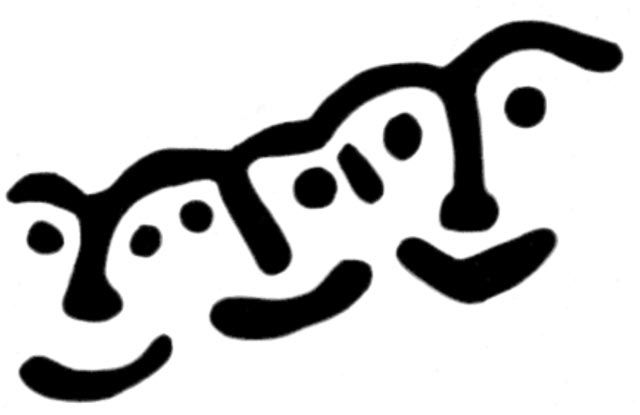Origins of the Alutiiq Alphabet
Alutiiq was originally an oral language, without an alphabetical form. However, there were forms of visual communication such as pictographs and petroglyphs. Although they don’t qualify as true writing systems because they lack direct word-for-word correspondence, these other forms of communication are an important part of our linguistic legacy.
Alutiiq Pictographs

Petroglyphs

Russian priests and Native students developed the first alphabetical form of Alutiiq in the early 1800s. These scholars used the Cyrillic alphabet to represent Alutiiq sounds. Remaining texts from this period include the Lord’s Prayer (1816), a catechism (1847), a primer (1848), and a Gospel of St. Matthew (1848). As Dr. Lydia Black laments in “Forgotten Literacy,” although this form of written Alutiiq was used throughout our homeland, it quickly faded after Americanization (Black 2001).
Dr. Jeff Leer developed the Alutiiq alphabet in use today, work that began in the 1970s (Counceller 2010). The alphabet for the Koniag dialect has 26 letters and is similar to the Yup’ik alphabet and writing system. The Alutiiq alphabet has undergone a number of minor modifications over the years, but has returned to the basic form introduced in Leer’s 1978 Kodiak Alutiiq Dictionary (Leer 1978).
This writing system is based on Roman alphabet characters, which do not always sound the same as English letters. There are also letters made up of two or even three Roman characters that are considered single letters, such as ll and hng. This alphabet and writing system are used in all Alutiiq Museum language materials, including the Alutiiq Word of the Week. The use of a unified writing system has been a central need for collaborative language efforts on Kodiak Island as the community strives to turn the tide on Alutiiq language loss.
References
Black, Lydia T.
2001 Forgotten Litteracy. In Looking Both Ways. A Crowell, A. Steffian, and G. Pullar (Eds.) Pp. 60-61. University of Alaska Press, Fairbanks.
Counceller, April Gale Laktonen
2010 Niugneliyukut (We Are Making New Words): A Community Philosophy of Language Revitalization. Doctoral dissertation, University of Alaska, Fairbanks.
Hoffman, W.J.
1882 Comparison Of Eskimo Pictographs With Those Of Other American Aborigines. in Transactions of the Anthropological Society, Pp. 128-146.
Leer, Jeff
1978 A Conversational Dictionary of Kodiak Alutiiq. Alaska Native Language Center, University of Alaska, Fairbanks.
Don’t Miss a Word!
Sign up for our email broadcast and we’ll send you a weekly language lesson and a link to our podcast.
Language Lessons
- Alutiiq – What is in a Name?
- Alutiiq and other Alaskan Languages
- Origins of the Alutiiq Alphabet
- Dialects and Styles of Alutiiq
- Language Loss & Revitalization
- Alutiiq Orthography
- Aapit – Alphabet
- Vowels
- Doubled Vowels & Diphthongs
- Consonants
- Stop Consonants
- Fricative Consonants
- Nasal Consonants
- Softening of Consonants
- Alutiiq Grammar: An Overview
- Pluralization
- Working with Noun Stems
- Working with Verb Stems
- Suffixes and Other Word Endings
- Postbases and Joining
- Alutiiq in Correspondence
- Kodiak Alutiiq Place Names
- Alutiiq Numbers
